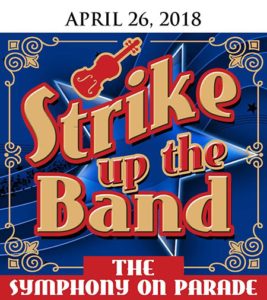Sponsored by
Re/Max Kerrville
Concert 5 “Strike Up the Band”
The Symphony on Parade
April 26, 2018 7:30 PM
New Season Announcement & Patron Ticket Reservation
Wine & Cheese Reception 6:00-7:30 pm
Cailloux Theater – Kerrville, Texas
Sponsored by REMAX/Kerrville
PERFORMANCES INCLUDE
Strike Up the Band Overture – George Gershwin
Suite from Karelia – Jean Sibelius
Trumpeter’s Lullaby – Leroy Anderson
George Eychner, Soloist
Circus Polka: for a Young Elephant – Igor Stravinsky
The Irish Dragoon, Circus Galop – John Phillip Sousa
Marche Slav – Pyotr Ilyich Tchaikovsky
Seventy Six Trombones, from The Music Man – Meredith Willson
Bugler’s Holiday – Leroy Anderson
A Salute to the Big Bands – Calvin Custer, arr.
Festive Overture – Dmitri Shostakovich
Conductor’s Letter
Dear Symphony of the Hills Friends,
On our final concert of the year, the symphony gives a salute to the band genre and its important role in the development of orchestral music. So much of our great orchestral music is inspired by concert and marching bands. Symphony orchestras include most of the band instruments combined with strings.
A perfect opener for this concert is George Gershwin’s Overture to his musical “Strike Up the Band.” Jean Sibelius, a famous Finnish composer, wrote incidental music for a heroic play that features marches in two of the three movements. John Phillip Sousa was a violinist and the most famous composer of marches in American history. His orchestral march The Irish Dragoon: Circus Polka shows the influence of circus music on band and orchestral music composition. Igor Stravinsky also wrote a march based on the frenetic energy of circus music. Tchaikovsky set his epic “Marche Slave” in a dramatic portrayal of the Serbian persecution in the late 19th century, musically expressing their oppression and their hope of a better future. This performance will conclude with Shostakovich’s Festive Overture, an orchestral work with extra brass instruments required. We welcome local high school band students who will join us toward the end of the work.
This concert showcase will be a thrilling conclusion to our season! And, we hope to see you back next fall!
With sincere appreciation for your attendance and support
Gene Dowdy
Conductor & Artistic Director
[sta_anchor id=”band-concert-notes” unsan=”band concert notes” /]Concert Notes
Strike Up the Band Overture
George Gershwin (1898 – 1937)
If you saved your concert program from the last concert, you may remember the brief biography of George Gershwin, which will not be repeated here. (If you would like a copy of any of the concert notes for this past season, just email us a request at info@symphonyofthehills.org.)
This overture is a 1927 composition by George Gershwin written for the 1927 musical Strike Up the Band, where it formed part of a satire on war and militaristic music, performed again in 1940. Although the musical was not successful, this particular piece has become quite well known, and has been recorded in various forms by a wide range of artists including Bing Crosby, Ella Fitzgerald and The Boston Pops Orchestra.
Suite from Karelia
Jean Sibelius (1865–1957)
Jean Sibelius, born Johan Julius Christian Sibelius, was a Finnish composer and violinist of the late Romantic and early-modern periods. He is widely recognized as Finland’s greatest composer and, by virtue of his music, is often credited with having helped Finland to develop a national identity during its struggle for independence from Russia.
Sibelius’s Karelia Suite, Op. 11, was written in 1893 for the Viipuri Students Association. It was premiered in the Imperial Alexander University in Helsinki, Grand Duchy of Finland, under the title Karelia Music. The suite is one of Sibelius’s earlier works and remains one of his most popular. The movements in the suite are all borrowed from the Karelia Music tableau that Sibelius was commissioned to write in 1893. It premiered in the Imperial Alexander University in Helsinki with Sibelius conducting, and the audience was enthusiastic, to say the least. As Sibelius noted later, “You couldn’t hear a single note of the music – everyone was on their feet cheering and clapping.”
The Karelia Music was written in the beginning of Sibelius’ compositional career, and the complete composition consists of an Overture, 8 Tableaux, and 2 Intermezzi. Karelia is close to 44 minutes in length. The suite we will hear this evening lasts about 12 minutes.
Trumpeter’s Lullaby
Leroy Anderson (1908–1975)
George Eychner, Soloist
Leroy Anderson was an American composer of short, light concert pieces, many of which were introduced by the Boston Pops Orchestra under the direction of Arthur Fiedler. John Williams described Anderson as “one of the great American masters of light orchestral music.” His name and his music are easily recognized by those of us who grew up in the Fabulous Fifties. His recordings during the fifties performed by a studio orchestra were immensely successful. Several of his compositions served as background music for early television programs.
A Trumpeter’s Lullaby is a short composition for solo trumpet and orchestra, written by Anderson in 1949. The two and a half minute piece was premiered on May 9, 1950, by the Boston Pops Orchestra with Arthur Fiedler conducting and French-born American Roger Voisin as trumpet soloist.
On the genesis of the piece, the composer states: “(A Trumpeter’s Lullaby)… had its beginning backstage at Symphony Hall in Boston. In addition to composing and conducting, I was Arranger for the Boston Pops Orchestra for a number of years–and after one of the concerts I was talking with the conductor Arthur Fiedler and the First Trumpet of the Boston Pops, Roger Voisin. Roger asked me why I didn’t write a trumpet solo for him to play with the orchestra that would be different from traditional trumpet solos, which are all loud, martial or triumphant. After thinking it over, it occurred to me that I had never heard a lullaby for trumpet so I set out to write one–with a quiet melody based on bugle notes played by the trumpet and with the rest of the orchestra playing a lullaby background.”
The result was phenomenal. The first stereo recording was made in October 1956 with Frederick Fennell conducting the Eastman-Rochester Pops Orchestra, recorded in one take without rehearsal.
Circus Polka: for a Young Elephant
Igor Fyodorovich Stravinsky (1882–1971)
Igor Stravinsky was a Russian-born composer, pianist, and conductor, widely considered one of the most important and influential composers of the 20th century. He first achieved international fame with three ballets: The Firebird (1910); Petrushka (1911); and The Rite of Spring (1913.) The first of these has been a recurring and very popular offering by American ballet companies. The last transformed the way in which subsequent composers thought about rhythmic structure and was largely responsible for Stravinsky’s enduring reputation as a musical revolutionary. Becoming an American citizen in 1945, he received a star on the Hollywood Walk of Fame and in 1987 was posthumously awarded the Grammy Award for Lifetime Achievement in 2004.
Circus Polka was written by Stravinsky in 1942. He composed it for a ballet production that the choreographer George Balanchine was developing for the Ringling Bros. and Barnum & Bailey Circus. The ballet was performed by 50 elephants and 50 ballerinas. According to Balanchine, he was contacted by the Circus to develop the choreography for this most unusual ballet and he immediately thought of Stravinsky, whom he contacted by telephone: Balanchine: “I wonder if you’d like to do a little ballet with me.” Stravinsky: “For whom?” Balanchine: “For some elephants.” Stravinsky: “How old?” Balanchine: “Very young.” Stravinsky: “All right. If they are very young elephants, I will do it.” In 1944, Stravinsky published an orchestration of the piece, which is now part of the repertoire of many orchestras.
The Irish Dragoon, Circus Galop
John Phillip Sousa (1854–1932)
John Philip Sousa was born in Washington, D.C., the third of ten children of João António de Sousa of Portuguese and Spanish ancestry and his wife Maria Elisabeth Trinkhaus, who was of Hessian descent.
John Phillip began his career playing violin and studying music theory. His father enlisted him in the United States Marine Band as an apprentice in 1868. After leaving the band in 1875, Sousa learned to conduct.
Sousa said a march ‘should make a man with a wooden leg step out’, and his surely did. However, he was no mere maker of marches, but an exceptionally inventive composer of over two hundred works, including symphonic poems, suites, songs and operettas created for both orchestra and concert band.
Sousa personified the innocent energy of turn-of-the-century America, still a new nation, and he represented America across the globe. His American tours first brought classical music to hundreds of towns. While Sousa’s fame as a bandmaster needs little comment, we are far less familiar with his formative years as an orchestral composer, conductor and violinist.
The circus has of course been an important inspiration for concert band musical compositions. Sousa’s operetta The Irish Dragoon was composed in 1915. For reasons still unknown, Sousa’s fully scored operetta was withdrawn without ever being performed. In any case, The Circus Galop is quintessential Sousa, with plenty of pizzazz, sure to get one’s blood flowing.
Marche Slave
Pyotr Ilyich Tchaikovsky (1840–1893)
So well-known is Tchaikovsky and his music, it is probably unnecessary to note that he was a Russian composer of the late-Romantic period, some of whose works are among the most popular in the classical repertoire. He was the first Russian composer whose music made a lasting impression internationally, bolstered by his appearances as a guest conductor in Europe and the United States.
Despite his many popular successes, Tchaikovsky’s life was punctuated by personal crises and depression, doubtless the result of an early separation from his mother, the death of his close friend and colleague Nikolai Rubinstein, and the collapse of the one enduring relationship of his adult life: an association with the wealthy widow Nadezhda von Meck. His homosexuality, which he kept private, has traditionally also been considered a major factor in his depression, though some musicologists now downplay its importance. Tchaikovsky’s sudden death at the age of 53 is generally ascribed to cholera, the result of his having drunk contaminated water a few days earlier.
Tchaikovsky’s “March Slave” had its origins in 1876, while Serbia and the Ottoman Empire were engaged in the Serbo-Turkish War. Russia openly supported Serbia and aided the war effort by various means. The Russian Musical Society commissioned an orchestral piece from Tchaikovsky for a concert in support of the Red Cross Society, and for the benefit of wounded Serbian veterans. Tchaikovsky’s musical efforts resulted in “Marche Slave,” to which Tchaikovsky referred as his “Serbo-Russian March.” It premiered in Moscow in November, 1876, conducted by Nikolai Rubinstein.
The march is highly programmatic in form and organization. The first section describes the Turkish oppression of the Serbs. It uses two Serbian folk songs, giving way to the second section in a major key meant to describe the Russians’ rallying to aid the Serbs. This section is based on a simple melody with the character of a rustic dance, finally giving way to a solemn statement of the Russian national anthem “God Save the Tsar.” The third section of the piece is a repeat of Tchaikovsky’s furious orchestral climax, repeating the Serbian cry for help. The final section uses a traditional Russian melody in the major key and includes another blazing rendition of “God Save the Tsar” prophesying the triumph of the Slavonic people over tyranny. The overture finishes with a virtuoso coda for the full orchestra.
The piece shares a few refrains with the 1812 Overture, with which it is frequently paired in performance.
Seventy Six Trombones, from The Music Man
Meridith Willson (1902–1984)
Meridith Willson was born in Mason City, Iowa. He attended Frank Damrosch’s Institute of Musical Art, which later became the Juilliard School. A skilled flute and piccolo player, Willson played with John Philip Sousa’s concert band (1921–1923), and then with the New York Philharmonic Orchestra under Arturo Toscanini (1924–1929). Willson then moved to San Francisco, as the concert director for radio station KFRC, subsequently becoming musical director for the NBC radio network in Hollywood. His name became synonymous with radio and motion pictures and is forever engraved in Hollywood as a star on the Hollywood Walk of Fame.
Willson’s most famous work, The Music Man, premiered on Broadway in 1957, and was adapted twice for film (in 1962 and 2003). He referred to the show as “an Iowan’s attempt to pay tribute to his home state”. It took Willson some eight years and thirty revisions to complete the musical, for which he wrote more than forty songs. The cast recording of The Music Man won the first Grammy Award for Best Original Cast Album. The piece “Seventy Six Trombones,” arranged by Leroy Anderson, is the signature song from The Music Man. In the musical, “Professor” Harold Hill uses the song to help the townspeople of River City, Iowa, visualize their children playing in a marching band by recalling a time when he saw several famous bands in a combined performance. While an average-sized high school marching band might have about 10 musicians playing the trombone and a large college marching band might have more than 30, the band that Harold Hill describes is unimaginable.
Bugler’s Holiday
Leroy Anderson (1908–1975)
Among the several legendary classical-pops pieces by Leroy Anderson that have remained popular, the Bugler’s Holiday (1954) is one of his most enduring classics. Originally scored for trumpet trio and orchestra, it has been performed by groups of nearly every musical instrument available, often to great comic effect. It could be noted here that a bugle is like a trumpet but without valves or other pitch-altering devices–melody control is done only by the player’s varying his/her embouchure. Consequently, the bugle is limited to notes within the harmonic series and thus is typically used with less complex tunes such as those of the military (think taps, the cavalry charge or reveille), the Boy Scouts and the call to post at Santa Anita. Bugler’s Holiday is a very difficult piece to play, usually employing a closely synchronized triple-tongued trio of trumpets or bugles.
A Salute to the Big Bands
Arr. Calvin Custer
We’re going back to the heyday of the Big Band era with the music of Glenn Miller, Benny Goodman, Tommy Dorsey and others. Calvin Custer takes you on a musical trip with this medley of the big hits from that time, including “April in Paris,” “Serenade in Blue,” “Sing, Sing, Sing,” “Pennsylvania 6-5000,” and more…
Festive Overture
Dmitri Shostakovich (1906–1975)
Born and raised in St. Petersburg, Russia, Shostakovich was a pianist and prolific composer of the Soviet period, and a major composer of the 20th century. He achieved fame in the Soviet Union under the patronage of a Soviet chief of staff, but later had a complex and difficult relationship with the government. Nevertheless, he received accolades and state awards, and served in the Supreme Soviet from 1962 until his death.
The Festive Overture premiered in 1954 at the Bolshoi Theatre in Moscow to commemorate the 37th anniversary of the October 1917 Revolution. Faced with a late request from the Bolshoi’s Conductor, Shostakovich completed the Overture in three days. It apparently is based on Glinka’s Ruslan and Lyudmilla overture (1842), with the same lively tempo, style of melody and conventional classical devices of form and harmony.
The overture begins with a fanfare by the brass, followed by a fast melody in the woodwinds. The strings take up this melody and the piece reaches a climax with a four-note motif. A more lyrical melody in the horns and cellos is then attained, although the tempo remains the same. Shostakovich develops this material in his typical style, using both themes in counterpoint before the fanfare returns and leads to a rousing coda. The piece has been played by concert bands all over the world; it was featured in the 1980 Summer Olympics in Moscow and the 2009 Nobel Prize concert.
Concert Notes by Jim Adams


